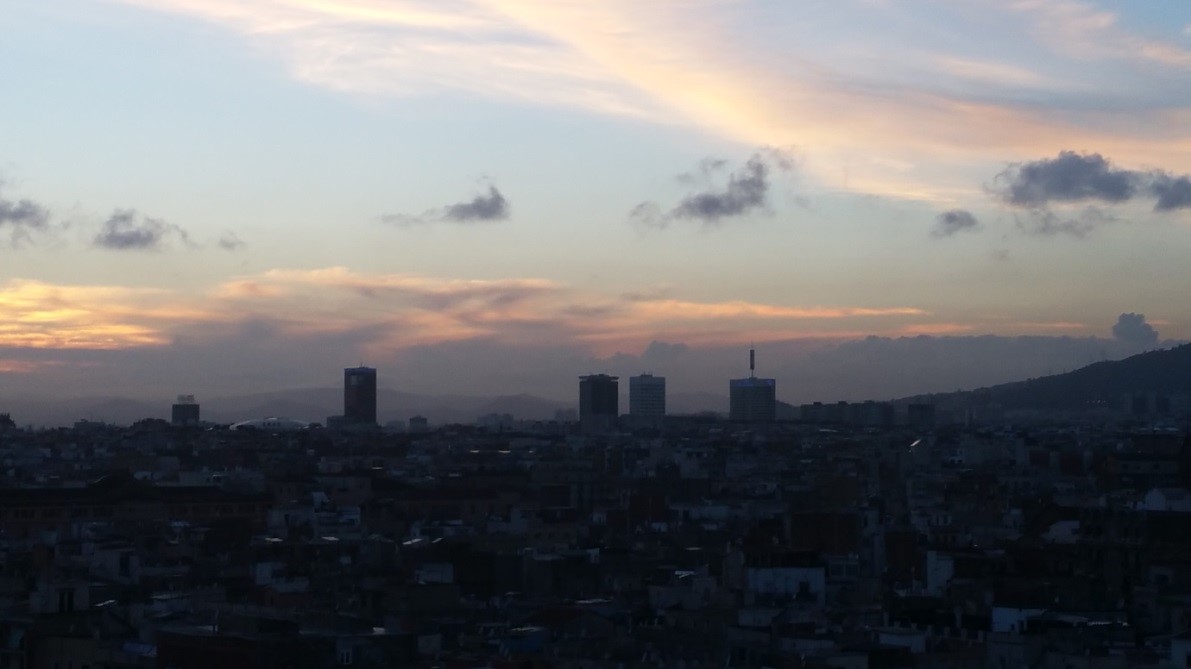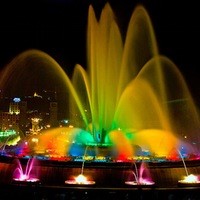
Barcelona Springs to Life - El Agua de la Vida
Posted on: April 2017Dr Mary Gearey University of Brighton
 |
Dr Mary Gearey, Research Fellow within the University of Brighton's School of Environment and Technology, conducts research which interrogates freshwater resources management and governance techniques, utilising political ecology and sustainable futures’ perspectives. She has recently completed her Daphne Jackson Trust Fellowship, undertaking empirical fieldwork along the River Adur in West Sussex, and is currently working on the AHRC funded ‘Towards Hydrocitizenship’ project and NERC’s ‘WetlandLIFE’. |
BARCELONA SPRINGS TO LIFE - EL AGUA DE LA VIDA !
In the famous Catalan fairy story ‚‘The Water of Life‘, also known by its original name ‘El agua de la vida’, only the deliverance of the water of life, sourced from a magic spring in the hills, can save a family from being turned to stone by an evil giant. It is the daughter of the family who outsmarts the ogre and restores life with the water. The life of her own family, of her petrified neighbours and of her surroundings are all rejuvanated as the water she spills on the return from the mountain turns everything green and fecund and frees the people from the giant’s curse. It is not hard to surmise that the family’s ‘beautiful palace overlooking faraway mountains’ is none other than the Palau de la Generalitat, originally built in the 15th century and located in the oldest part of Barcelona. That water is still seen as the very essence of Catalan life is clear throughout the urban fabric of its capital city.
Wedged between the Mediterranean Sea and the estuaries of the Llobregat and Besos rivers and with the Serra de Collserola mountain range as its backdrop, Barcelona is a water-centric city fiercely proud of its heritage. As the economic powerhouse of Catalonia, its historic wealth was built around its port, driving its shipping, mercantile, leather and textile industries. The evidence of that financial prowess – Barcelona’s architectural splendour - attracts millions of tourists every year. Power, water, wealth have historically connected together to forge a city of almost 2 million residents; whose population rises threefold every year with almost 6 million visitors per annum.
As one of those 6 million visitors I travelled to Barcelona in early February this year as part of an EU ‘Co-operation in Science and Technology’ initiative. My fellow Sustainable Futures researchers and I first met as a group as the streets of Barcelona were swelling, not thinning out. This particular Sunday night was the final night of the ‘Festa da Santa Eulalia’ celebrations. A gruesome story concerning the murder, and subsequent martyrdom, of a Christian adolescent, Eulalia, by the Romans occupying Barcelona, the annual festival in her honour is now a winter time children’s event, with parades, dancing, music and, when we arrived, a final night spectacular outdoor light show in one of the city’s main squares.

Sunset over Barcelona February 2017
As we walked home from our conference dinner we were swept into city life. Barcelona was ablaze with light, with people out in the night airs, watching the spectacle with their families, their young children enraptured by the amazing choreographed ‘son et lumiere’ storytelling unravelling before their eyes. For a weary British traveller who had left the University of Brighton in sub-zero temperatures before boarding the plane to Spain that morning, to be standing outside in a clement star filled evening seemed almost unreal. What had brought these diverse people together to share this festival experience? The crowd were amazed and awed by the lasers and the music which thumped in the chest, exhilarating the senses. I asked a local if they were enjoying themselves. ‘Of course’, they said, ‘but to see something really special, you should see the Font Magica’: the Magic Fountain.

Sants-Montjuïc fountain, Barcelona
As it turns out, calling it a ‘Magic Fountain’ doesn’t do it justice. It’s a ‘Son et lumiere et agua’ spectacular that involves water, lighting and sound, and takes in not just the Sants Montjuic fountain, sitting at the base of the Montjuic slope, but also the subsidiary fountains and cascades along the Avinguda de la Reina Maria Cristina. But not just any sound and lightshow – there’s a theme for every taste. The haunting sounds of ‘every breath you take’ by the Police? Then it’s the 80s night for you. Feeling inspired? That will be the breathtaking fretwork on the Spanish classical guitar musical segment. This is the true arena of the selfie stick.
There is a serious side though. Designed by Carles Buiges, and opened on May 29th, 1929 as part of the International Exposition of Barcelona, the original Font Magica was a testament to Catalonia’s hydrological prowess. As one of Spain’s intellectually and economically dominant regions, the fountain was in part an homage to, and celebration of, Catalonia’s hydraulic feats. Catalonia lead Spain, post Civil War, in its swift execution of a huge nationwide network of dams, aquaducts and drainage channels. These transported water across hundreds of miles of arid land to provide irrigation for farming and to support economic development in its emergent cities. The country’s hydraulic revolution has been lauded for the past sixty years and is summed up by the title of Erik Swyngedouw’s recent book on the subject: ‘Liquid Power’, reflecting the contested and dark narratives that underpin the means by which the control and flow of water has shaped modern Spain.
Nowadays the Font Magica is regarded more as a tourist attraction rather than as a testament to patriotic pride, and is a main feature on Trip Advisor’s ‘must see’ list for the city. The Font Magica performances are throughout the year, and every half an hour on weekend summer evenings, creating a family orientated night time micro economy for this part of the city, away from the old, and dominant, gothic quarter. As a result of its infamy, and no doubt due to its economic impact on the city’s tourist culture, the fountain is never allowed to run dry. Even in the sultry summer months since its revival as a functioning water feature in 1955 it has never been turned off, even in very dry spells.
But how long may this continue? Future predictions regarding the impacts of climate change on drought events and heatwave frequency in the city indicate that water efficiency strategies and policies to both reduce water use and find new water supply sources are likely to become more urgent. Since 2009 Barcelona has already installed a large desalination plant to augment local water supply after plans to transfer water from the river Ebro, some 180 miles away, stalled. Water is increasingly viewed, and pitched, as a scarce resource. Domestic water consumption levels are declining, but Barcelonians are feeling the impact of high water charges on their pockets. In recent years the local federation of neighbourhood associations has headed a consumer strike, advising citizens in some local districts to refuse to pay household water bills in protest against the rapid hiking of water tariffs and the inclusion of sewerage undertaking and waste disposal services in these charges. They argue that lumping these different services together, and changing the charging structure to increasing block tariffs (with the quota set so low it’s hard for anyone to meet it and rising block prices too high) rather than linear metering, adversely impacts on lower income families and makes it harder for all householders to reconcile the water they use with the final bill they pay. Spanish Water Law still has not addressed these issues effectively and the post 2008 financial crisis has had very stark impacts on low income families: non-payment currently has as much to do with an inability to pay as a reaction to the oblique charging methods. In 2012 some 65,000 domestic water bills were left unpaid according to the Confederation of Neighborhood Community Groups of Barcelona (source: March and Sauri, 2016:11).
This leads us to an ethical dilemma – if water is for life whose life, whose comfort, matters most – the people who live in the city, or the tourists who spend money in the city? Does the Magic Fountain’s ability to draw crowds help support the city’s economy, and spread benefits and generate taxation efficiently and equitably enough; or should some of the benefits from this magic water show and the tourist money it helps generate go directly to benefit those families on low incomes who struggle with their high household water bills? As the city moves on with its visionary planning to create a Sustainable Barcelona, planning, adapting and transitioning to cope with the long term impacts of increasing urbanisation, tourism and climate change, the city planners will have plenty of social justice issues to wrestle with. Let’s hope the Magic Fountain continues to spread its good cheer across the years – and remind us all that the water of life is what we need for happy healthy lives together; and that this fundamental right to affordable water - for equity, for dignity, for health and social inclusion –should not just remain the stuff of fairy tales...



